Michigan, with its unique climate and distinct seasons, offers a promising environment for various fruit trees to flourish. For those keen on transforming their backyards into fruitful orchards or simply dabbling in some casual gardening, knowing which trees thrive here is essential.

This article is designed to navigate you through the top choices for the state’s climate. Whether you dream of juicy apples or tangy cherries, we’ll help you select the perfect tree for your Michigan garden, setting the stage for bountiful harvests in the coming years. So, let’s get into it.
1. Apple (Malus domestica)
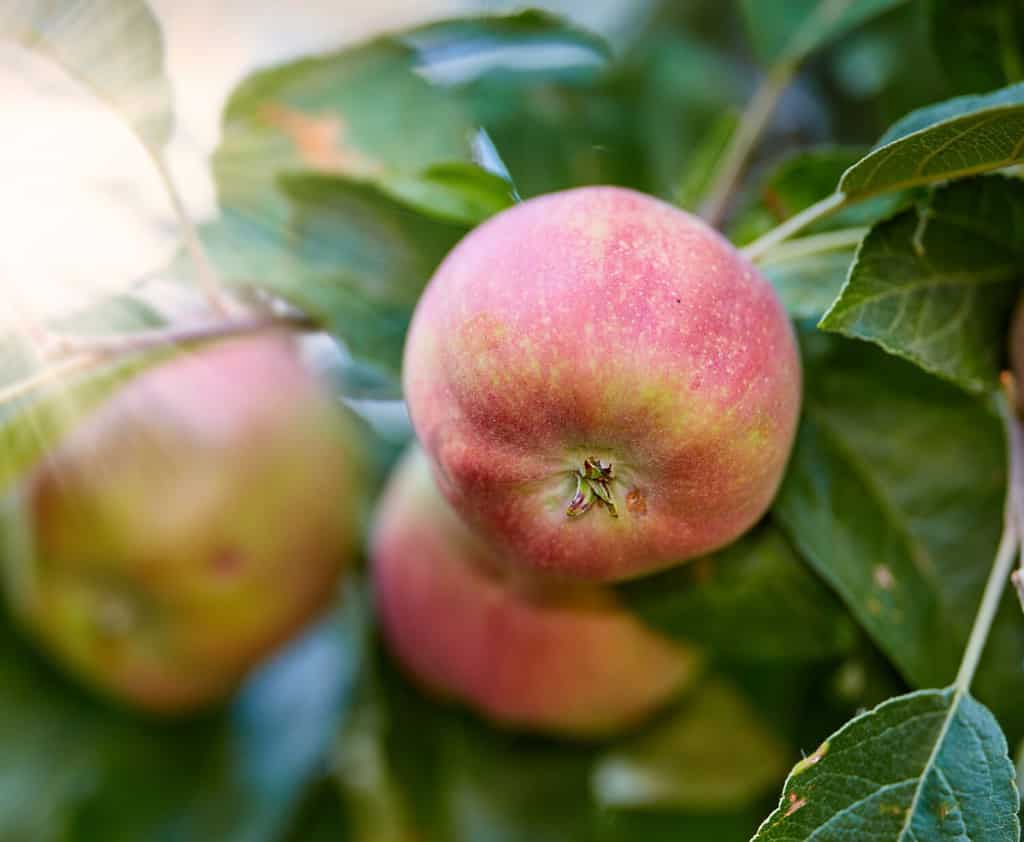
Apple trees are one of the best fruit trees to plant in Michigan.
©PeopleImages.com – Yuri A/Shutterstock.com
Michigan holds a special fondness for apple trees, with numerous apple varieties taking root in its soil. Among these, the Honeycrisp and Honeygold have carved a niche for themselves.
The apple tree showcases leaves that are wide, flat, and green with a simple, unlobed structure, although some might have tiny serrations along the margins. Its flowers, which bloom in spring, exhibit a gentle white hue, subtly tinged with pink at the edges, and usually consist of five petals each.
Though the edible varieties of apples don’t flourish when planted directly from seed, they prosper when grafted onto rootstocks. These grafted trees come in different sizes: dwarf (8-10 feet), semi-dwarf (12-15 feet), and standard (18-25 feet), but the fruit remains full-sized across all.
Standard trees might keep you waiting six to 10 years, semi-dwarfs will start fruiting in about 4 to 6 years, and the eager dwarf trees will present apples in just three to four years.
These resilient trees continue to blossom and bear fruit even when faced with a surprise spring snowfall or frost.
Growing Tips
- Apple trees thrive in full sunlight and do best in deep, loamy, moderately fertile soil that can retain a bit of moisture yet is well-draining.
- It’s advisable to place them in an area that’s shielded from intense frost.
- For best results, plant apple trees when they are dormant, typically from late fall to early spring.
Hardiness zones 3 to 8 are optimal for most apple varieties, making them a fitting choice for Michigan.
2. Pear (Pyrus)

Pear fruit trees are another delicious addition to add to any Michigan garden.
©Jennifer Bosvert/Shutterstock.com
In Michigan, pears thrive, finding favor across both its southern and northern parts. Distinctive features of the pear tree include its leaves, which are oval in shape with subtly toothed margins. Top pear varieties include Bartlett, Kieffer, Anjou, and Bosc.
Pear trees owe their size largely to their rootstock. A typical pear tree, when grafted onto a standard rootstock, can stretch up to 30 ft in height and span 20 ft across. However, for those seeking a more compact option, dwarf rootstocks allow pear trees to maintain a cozier height and breadth, reaching only about 8 to 10 ft in both dimensions.
When it comes to patience, pear trees test it. They could have you waiting anywhere between 3 to 10 years for their first bloom and fruit. Yet, some pear variants, like the Anjou, Harrow Sweet, and Moonglow, might surprise you by fruiting a tad earlier than others.
Growing Tips
- To blossom well, pear trees require a good dose of winter chill.
- These trees relish full sunlight and thrive in deep, nourishing, moist soils. They’re more forgiving than most fruits when it comes to dense or imperfectly draining soils.
- Their early spring blossoms are vulnerable to late frosts; hence, securing them a warm spot that faces the south or west, shielded from intense cold, can make a difference.
- It’s best to plant pear trees during their dormant phase, either at the tail end of winter or as spring begins.
Fittingly, most pear trees are suited for growth in hardiness zones 4-8, making them a splendid pick for Michigan gardens.
3. Cherry (Prunus avium)
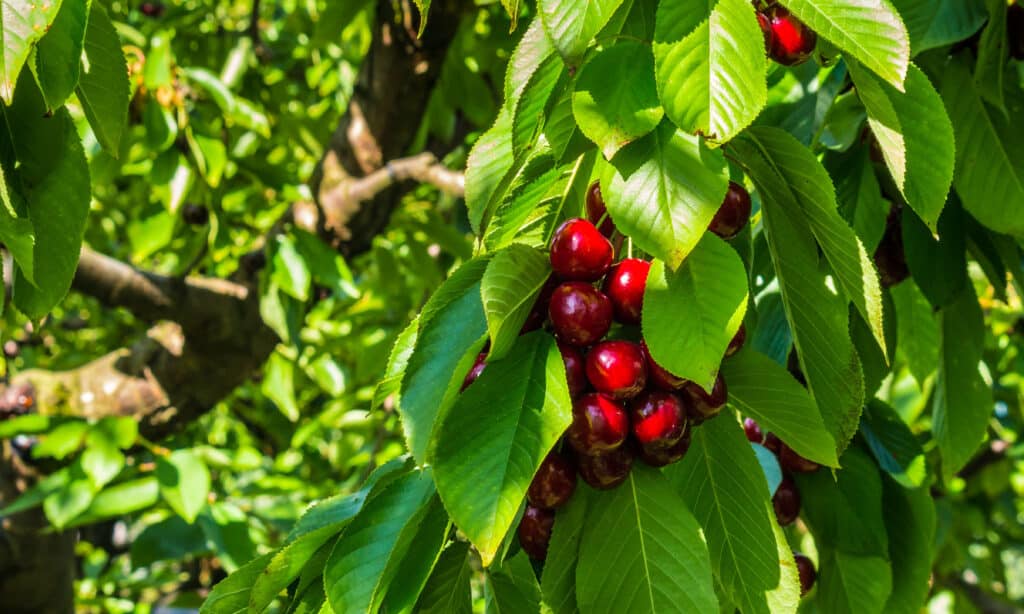
Cherry trees start producing fruits anywhere between 3 and 9 years after planting.
©patjo/Shutterstock.com
Northern Michigan offers the perfect conditions for growing cherries. Cherry trees, which shed their leaves annually, produce a juicy fruit with a central stone and are a part of the Prunus family within the larger Rosaceae group.
The most commercially popular are the sweet cherries (Prunus avium) and the tart varieties (Prunus cerasus). Depending on its type, a cherry tree’s height can range from 13 to 50 feet, with tart ones being on the shorter side. However, compact variants are also available.
Generally, they start bearing fruits about 3 to 9 years after planting, depending on the type. They can live for over six decades, though fruit production dwindles after 40 to 50 years. These trees feature simple alternating leaves, reddish-pink buds, and clusters of white or pink blooms in early spring. The fruit, known as cherry, can be round or heart-shaped and varies in color from red to yellow or black.
Growing Tips
- Ideally, cherries should be planted after the last frost of spring. In Michigan, that’s usually after the Memorial Day weekend.
- Choose elevated areas for planting to avoid waterlogging.
- A well-draining soil, free from dense clay or stones, supports cherry growth best.
- A sunny location with a minimum of 6 to 8 hours of sunlight daily is essential for their growth.
- During their initial phase, these trees need ample water. If it’s not raining, water them daily.
- For optimal growth, feed cherry trees with a balanced mix of nitrogen, phosphorus, and potassium during the growing season.
These cherry varieties trace their roots back to the colder regions of western Asia and Europe. They thrive in USDA hardiness zones 4 through 7, making them suitable for places like Michigan.
4. Peach (Prunus persica)
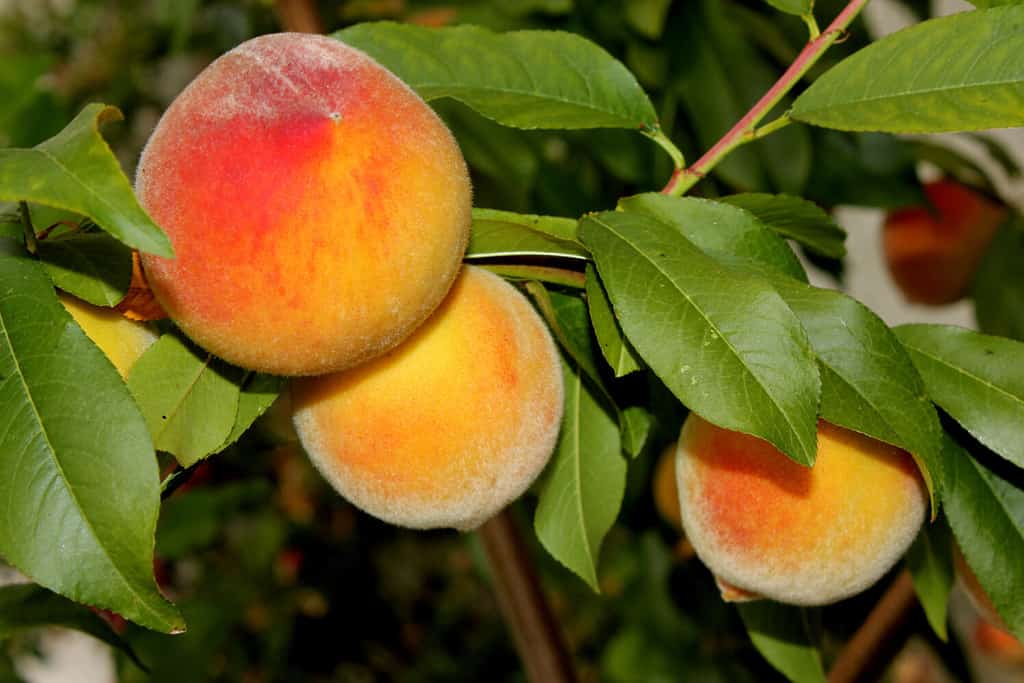
Peach trees are a great fruit tree choice for Michigan gardens.
©Gurcharan Singh/Shutterstock.com
Peaches are a top choice among fruit enthusiasts in Michigan. For optimal growth in Michigan’s unpredictable cold spells and occasional late frosts, it’s best to opt for varieties like the PF-24C, known for its impressive cold resistance.
The peach tree showcases slender, elongated leaves measuring between 2.8 to 6.3 inches. As spring approaches, the tree bursts into a spectacle of pink blooms, usually appearing in singles or pairs. These flowers pave the way for the leaves, blossoming ahead of the green foliage.
While a standard peach tree can stretch up to 25 feet both in height and width if not trimmed, there are also more compact dwarf types that stand around 6 feet tall and wide. Typically, peach trees start bearing fruit between their 2nd and 4th years, hitting optimal yields around their 5th year. A well-cared-for tree can continue producing delicious peaches for 10 to 15 years or even longer.
Growing Tips
- Optimal planting time for peach trees is in the late winter or the onset of spring during dormancy.
- Ensure they bask in full sunlight; those in shaded areas tend to be less robust and more prone to pests and diseases.
- Aim for well-draining soil with a slightly sandy texture for these trees.
- For the initial couple of years, consistent watering is crucial to help them take root.
- Every spring, bolster their growth with a 10-10-10 balanced fertilizer.
Suited for USDA Hardiness Zones between 4 to 10, peaches find a perfect home in Michigan.
5. Plum (Prunus domestica)
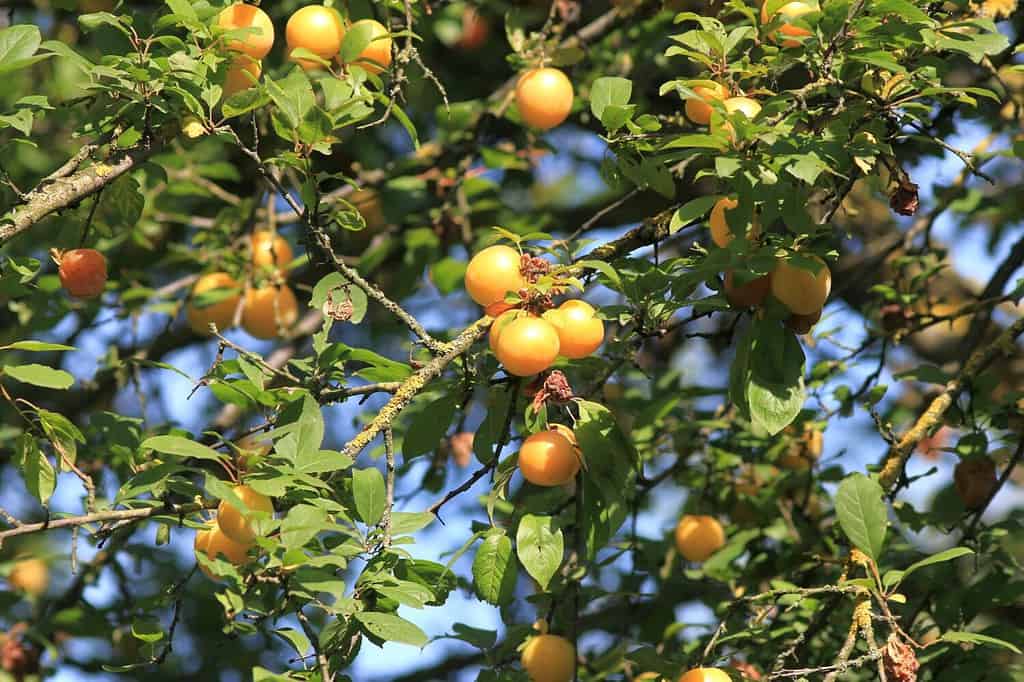
Some varieties of plum trees are known to withstand temperatures as low as -40°F!
©Dina Rogatnykh/Shutterstock.com
Plums thrive in various parts of Michigan, especially near the Great Lakes. The Alderman variety is a top choice for the region, renowned for its resilience to Michigan’s cold, withstanding temperatures as low as -40°F.
These trees, often having a shrub-like appearance, exhibit a deep-brown bark. Their branches typically grow in a straight pattern, and in their wild forms, the twigs may carry spines. A notable feature of the plum tree is its leaf stem, which is slightly hairy and usually hosts a pair of yellowish-green glands.
Standard plum trees usually reach a height of around 18 to 20 feet, though, in perfect conditions, they can grow even taller. These trees start bearing fruit between their third to sixth year, but some varieties might surprise you by producing small fruits even earlier.
Growing Tips
- Best time to plant? Late winter to early spring, during the tree’s dormancy phase.
- Sunlight is essential. Ensure they receive a minimum of 6 to 8 hours of direct sunlight daily.
- Go for well-draining, loamy soil. Clay-rich or consistently soggy soils are not plum-friendly.
- Steer clear of frost pockets, as settling frost can harm your young trees.
- During their first year, ensure young trees get plenty of water each week to spur growth.
Adaptable to a range of climates, plums are comfortable in USDA zones 3 to 9. This makes them a versatile fruit tree, fitting for various regions of the U.S., including Michigan.
6. Apricot (Prunus armeniaca)
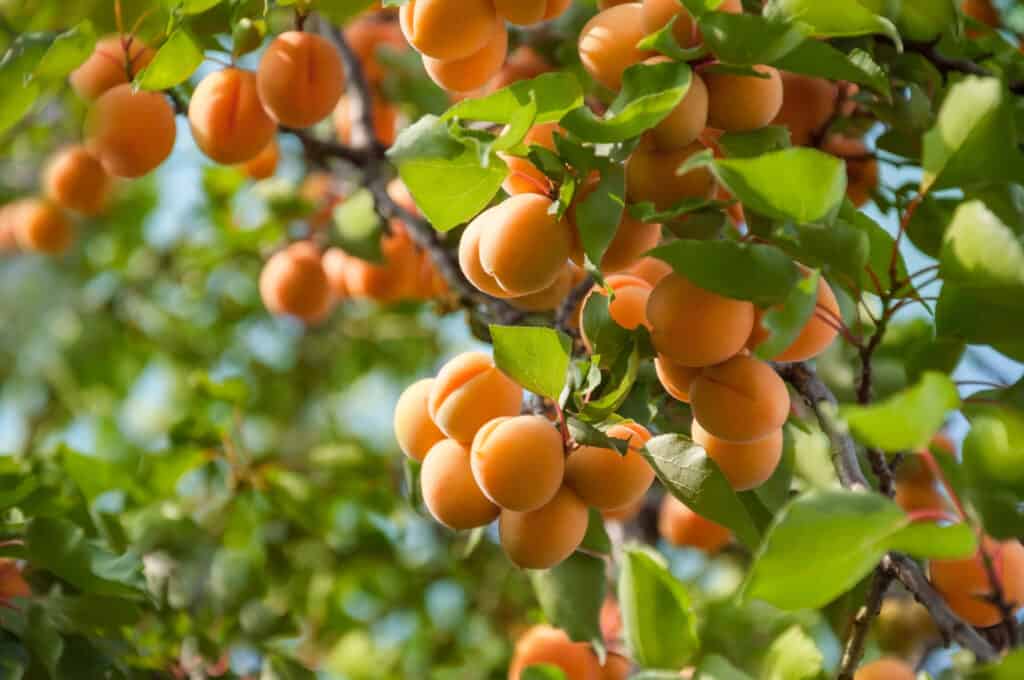
Another great fruit tree for the climate, Westcot apricots are a great pick for the Michigan gardens.
©iStock.com/Zoya2222
Apricots are well-suited for Michigan, with the Westcot variety standing out as the top pick!
Originating from parts of China and Central Asia, the apricot tree, known scientifically as Prunus armeniaca, sheds its leaves come winter. These trees can stretch up to 39 feet tall, but through pruning, they’re typically kept at a manageable height of around 12 to 13 feet. Sporting oval leaves around 2 to 3.5 inches in length, the apricot heralds spring with its white-to-pink blossoms that burst into bloom even before the leaves make their appearance.
While apricot trees generally start yielding their juicy fruits between their second and fourth years, they continue to be fruitful for an impressive 20 to 25 years, sometimes even longer. Apricots are known botanically as drupes, similar to peaches and cherries.
Growing Tips
- Fall is ideal for planting apricots, as it prepares them to root before the winter.
- Opt for a sunny spot where the soil is both fertile and drains well.
- During spring, apply a fertilizer designed for fruit trees.
- Layer the base with about three inches of organic mulch.
While apricots can handle conditions in USDA Zones 3 to 8, a late frost might hinder fruit production.
7. Nectarine (Prunus persica)
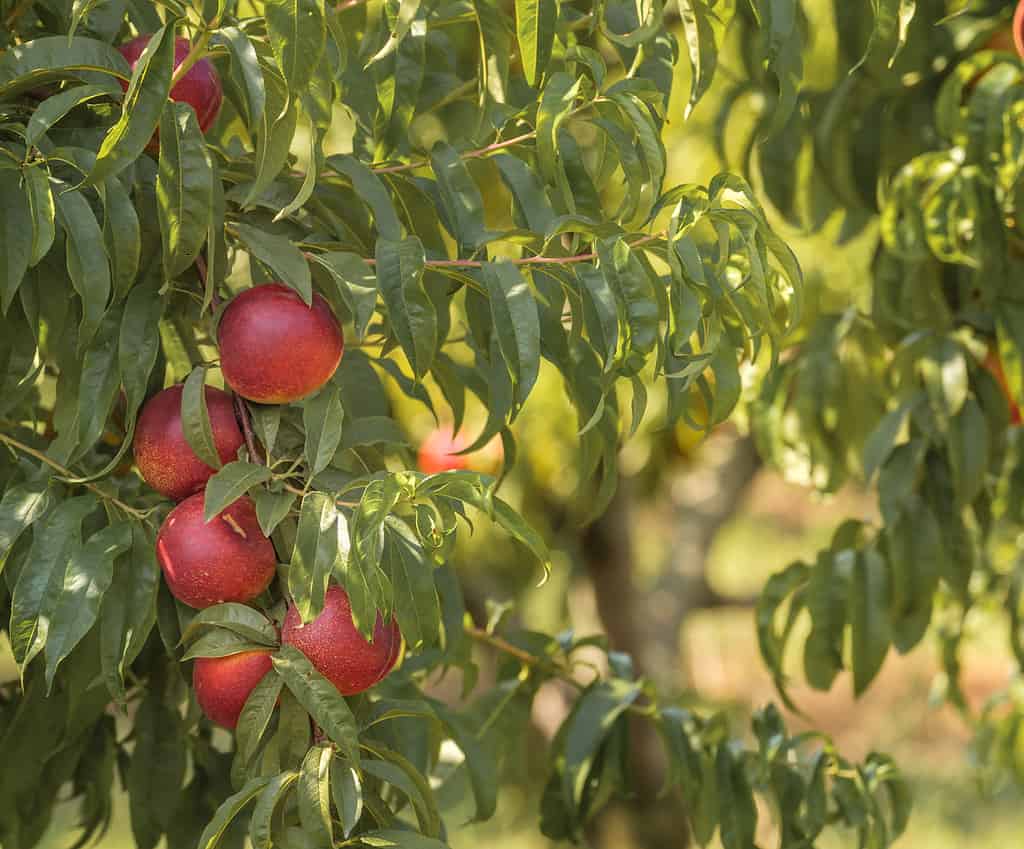
With some winter care, nectarines can also thrive in Michigan’s colder climate.
©IonelV/iStock via Getty Images
Nectarines can grow in Michigan with a bit of extra winter care. For those in Michigan’s colder northern regions, nectarines might need some protection, especially if temperatures often fall below 20°F. Wrapping them in burlap during such chilly spells can offer the necessary shield.
Nectarines, close kin to peaches, have smooth skin. Opting for a dwarf variety? Expect it to reach heights and widths of about 8 to 10 feet, producing generous amounts of standard-sized fruit. In contrast, standard nectarine trees can grow between 12 to 15 feet tall and spread about 15 feet wide, ideal for those who have ample space or desire shade.
It typically takes a nectarine tree two to four years from its sapling phase to start bearing fruit.
Notably, Independence nectarines have a reputation for cold hardiness and are celebrated for their delightful sweetness. Their vibrant red hue indicates when they’re ripe and ready for consumption. A bonus: Independence nectarines can pollinate themselves!
Growing Tips
- It’s best to plant nectarines during fall to spring.
- Make sure they get plenty of sunlight.
- Use well-draining, average soil.
While best suited for USDA Zones 6 to 8, Michigan gardeners can successfully grow them with cold-hardy varieties and a bit of winter care.
8. Pawpaw (Asimina triloba)
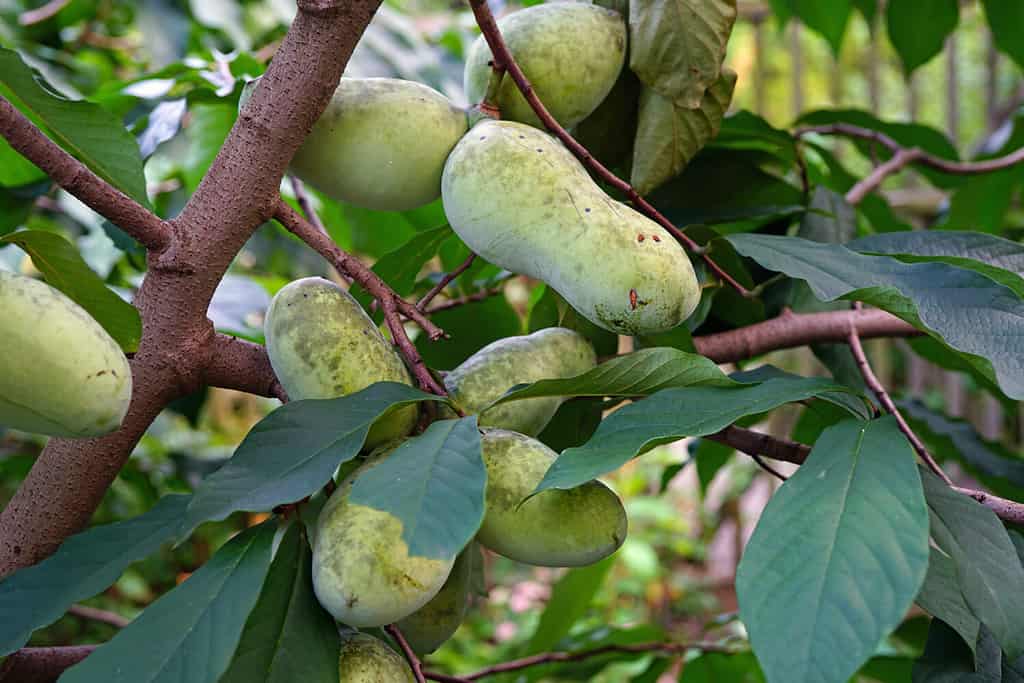
Native to the state, pawpaw trees can grow up to 40 feet tall.
©EQRoy/Shutterstock.com
Pawpaws are native trees found across North America, extending from the Midwest through the South and up to the eastern regions, including Michigan.
The tree has an interesting, almost droopy appearance, as if the branches are struggling to hold up the leaves. In the spring, the tree displays robust, deep red or purple flowers. The fruit of the pawpaw is encapsulated in a green outer layer, and its insides can range from yellow to golden or even white.
Typically, a pawpaw tree stands around 15 to 20 feet tall and wide. However, in prime conditions, it might even grow between 30 to 40 feet. If you choose a grafted tree, expect fruits in two to three years. To ensure fruit production, it’s a good idea to get at least two trees, as they need to cross-pollinate.
Growing Tips
- Plant pawpaw trees during the springtime or fall.
- For optimal growth, especially in their younger years, keep them in partial shade to protect them from leaf burn. However, as they age, they can handle full sunlight.
- Ensure the soil is rich and offers good drainage.
- Keep the soil moist, especially for younger trees.
- Fertilize your pawpaw tree twice annually to ensure robust growth and bountiful fruit harvest.
Pawpaw trees are resilient to cold, suitable for USDA zone 5, and can brave temperatures as low as -20°F.
9. Mulberry (Morus alba)
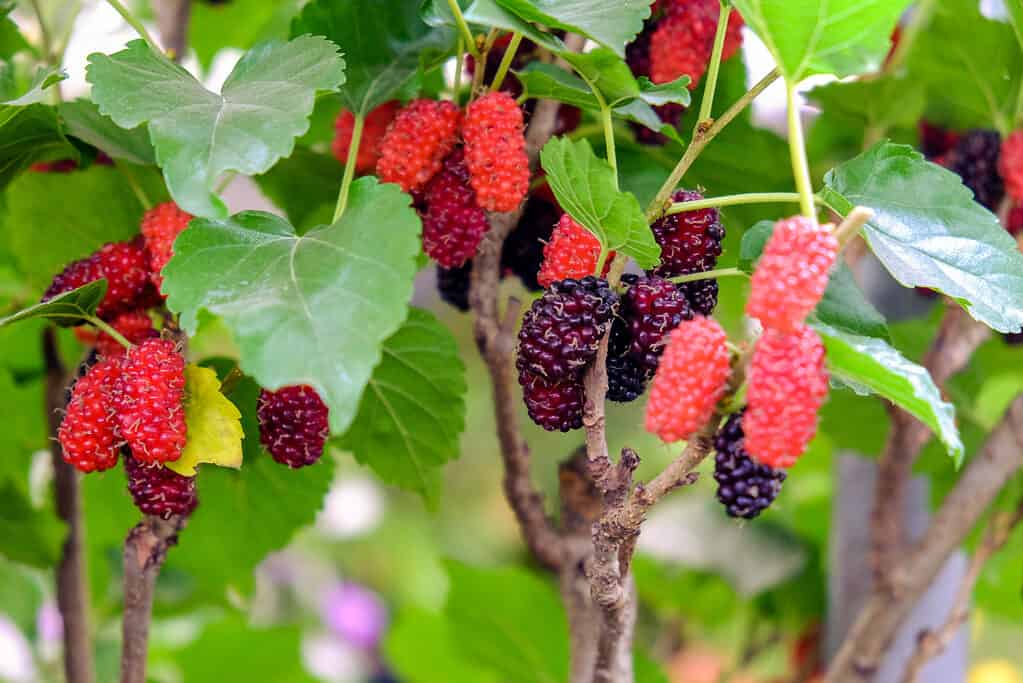
Another great fruit tree for a Michigan garden is the mulberry tree.
©Aunyaluck/Shutterstock.com
Mulberry is a local favorite in the lush forests of southern Lower Michigan and is a top pick for backyard planting. The trunk of this tree starts with a youthful light gray hue, which gracefully transitions to an amber or muted orange-gray as the years pass. The tree boasts fruits that transition from a reddish hue to deep black, prized for their quality.
As for the size, a standard mulberry tree can soar between 30 to 60 feet. However, if you opt for the dwarf everbearing variety, you’re looking at a more manageable 10 to 15 feet. Planting a mulberry seed requires patience; it will typically take around 5 to 6 years on average before it offers its first batch of fruit.
Growing Tips
- The prime time to introduce a mulberry tree to your garden is during the spring.
- They aren’t fussy about sunlight; they can flourish in full sun or even under partial shade.
- While mulberries are versatile and can adjust to clay, sandy, or loamy soil, it’s essential that the soil allows good drainage.
- When you first plant it, water the tree deeply and consistently, aiding in root establishment.
- With resilience to chilly temperatures, many mulberry varieties can endure lows of up to -25°F.
- Although they can prosper without fertilizers, a yearly dose can boost their health and yield.
Being suited to USDA Zones 4 to 8, they’re a fitting choice for the Michigan climate.
10. Medlar (Mespilus germanica)
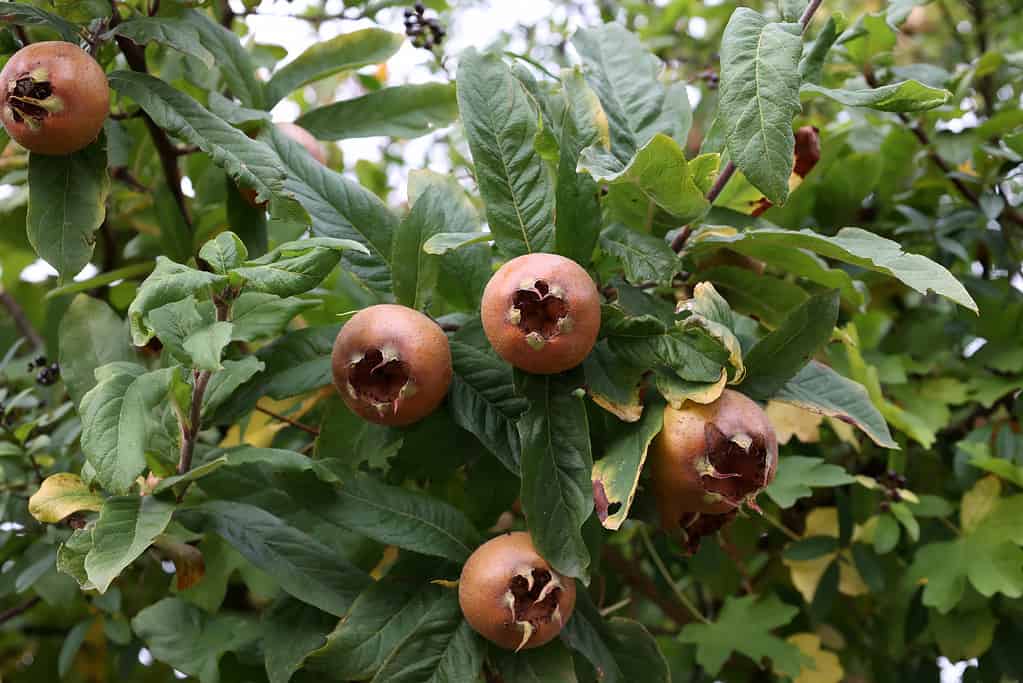
Medlar trees can begin bearing fruit at around 2 to 4 years old.
©Leo Malsam/iStock via Getty Images
Often overlooked, the medlar tree is surprisingly well-suited for Michigan gardens. Typically, medlars are modestly sized, deciduous trees boasting a rounded, drooping canopy. The fruit of the medlar, set against a rich reddish-brown backdrop, has an unusual appearance. About the size of a large cherry, its wide sepals form a protective ring around the center, making it look almost hollow. When you take a bite, its sweetness will remind you of a perfectly ripened date layered with intricate flavors.
In optimal conditions, these trees can stretch to 25 feet and might even resemble expansive shrubs or dense clusters. They begin bearing fruit as early as 2 to 4 years old.
Growing Tips
- Consider planting your medlar during the fall to spring for the best results.
- Choose a spot where it will receive ample sunlight.
- Opt for fertile soil that can retain moisture without waterlogging.
- Ensure consistent watering during its first growth year.
- Impressively, medlars can endure temperatures as chilling as -30°F, though a range of 15°F to -5°F is more common.
Ideally, they thrive in USDA zones 5 to 7.
11. Persimmon (Diospyros kaki)
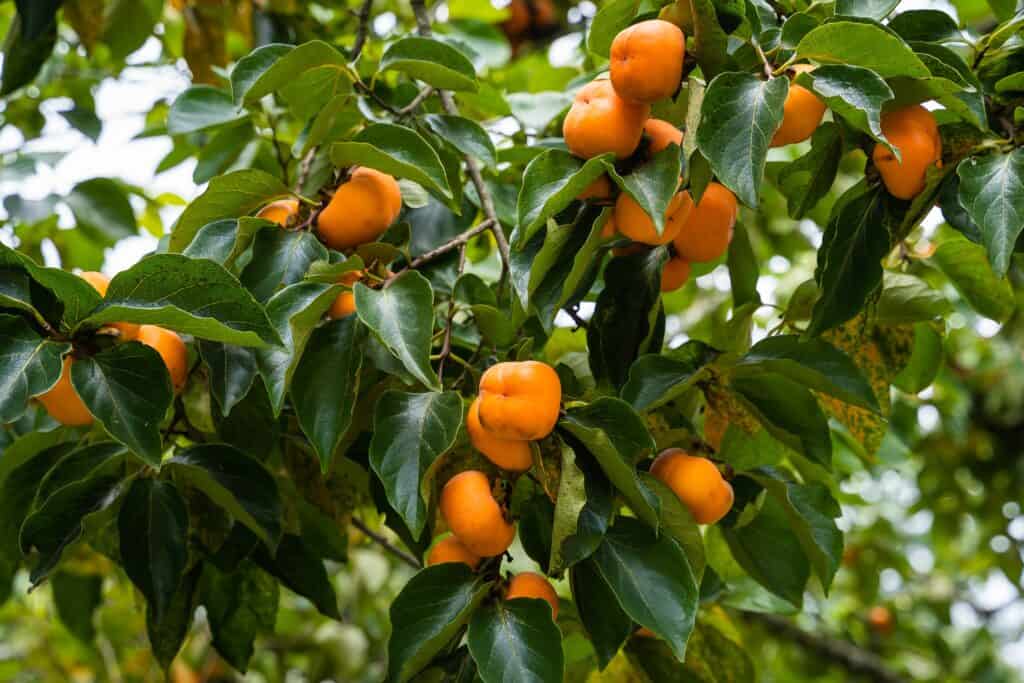
Some persimmon trees can endure temperatures as low as -25°F!
©Supermop/Shutterstock.com
Did you know Michigan’s home gardeners can grow their own persimmon trees? Impressively, the native American persimmon can endure frigid temperatures, even plummeting to -25°F!
These trees boast vibrant green leaves during the summer, which undergo a beautiful transformation, adopting yellow and reddish-purple hues in the fall. By late spring, their beauty is further accentuated by the blooming of enchanting white or yellow bell-shaped flowers. As for the fruit, it’s a visual and gastronomic delight – presenting a creamy yellow-orange inside with a consistency resembling soft jelly, while the outside exhibits colors spanning from light yellow to a rich red-orange.
When it comes to size, persimmon trees can vary. A fully grown one can soar up to 60 feet. However, they grow at a leisurely pace, which means it’s possible to keep them at a more manageable height of around 12 to 20 feet.
It might take up to nine years for these trees to start yielding fruit, but once they do, they can keep producing for many more years.
Growing Tips
- Plant the tree into the ground after the last spring frost or before the first fall frost.
- A location with full sunlight is optimal for persimmon trees.
- They prefer sandy loam soil that’s both fertile and drains well. However, they’re pretty adaptable to various soil types.
- Once established, ensure the tree gets a minimum of an inch of water weekly.
Suitable for hardiness zones ranging from 4 to 9, persimmons are a great choice for Michigan gardens.
Summary of 11 Best Fruit Trees That Grow In Michigan
| Number | Fruit Tree | Botanical Name |
|---|---|---|
| 1 | Apple | Malus domestica |
| 2 | Pear | Pyrus |
| 3 | Cherry | Prunus avium |
| 4 | Peach | Prunus persica |
| 5 | Plum | Prunus domestica |
| 6 | Apricot | Prunus armeniaca |
| 7 | Nectarine | Prunus persica |
| 8 | Pawpaw | Asimina triloba |
| 9 | Mulberry | Morus alba |
| 10 | Medlar | Mespilus germanica |
| 11 | Persimmon | Diospyros kaki |
The photo featured at the top of this post is © IonelV/iStock via Getty Images
Thank you for reading! Have some feedback for us? Contact the AZ Animals editorial team.







